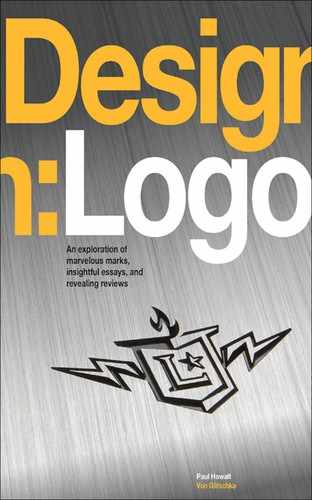
(Ray)
(Fogra 39)Job:08-30930 Title:RP-Design Logo
#175 Dtp:225 Page:6
001-272_30930.indd 6 9/2/13 9:53 AM
(Text)
Introduction
We can all respect the heritage of the ubiquitous logos of
corporate giants such as Samsung, McDonald’s, Walmart, Face-
book, IBM, and Sony; but as designers, we realize that so many
of these marks for large entities show obvious signs of being
pushed, pulled, strangled, and beaten into creative submission
and sterility. No matter how much the initial brief may tout the
brand as being personable and able to provide an emotional
connection to a community, the logo ends up reecting none
of the human qualities it brags about. The resulting logo ends up
being merely an expensive, impotent placeholder—unoensive
yet uninspiring. This book is not about any of these.
On the other hand, there are logos that grab us by the eyeballs,
hug our souls, endear our senses, and don’t let go. If you’re
one who has chosen graphic design and branding for a living,
we doubt that you’ve been inspired to do so by the creative
battles that produced marks for any of the corporations named
above. I’d venture a guess that most of us were motivated by
logos that displayed distinctively clever visual concepts, told a
story, or were rendered with industry-dening style. I’m talking
about logos such as the old Milwaukee Brewers “ball and glove”
monogram from the ‘70s, the Armor All Viking brand character,
the Baskin Robbins “31 avors” mark, the Android OS logo, the
Twitter bird and the Atlanta Falcons “F” symbol. We all recognize
these logos as being brilliant, conceptual, and bold. We marvel
at these marks, smile, and can’t look away.We e
with open arms. We run to become members of their brand
tribes. They are, in a word,
Competitive brands are nding the need to court their cus-
tomer and communicate their message quicker and more
thoroughly. That’s a tricky tightrope to walk. Every detail and
attribute of a logo needs to be carefully scrutinized before
(Ray)
(Fogra 39)Job:08-30930 Title:RP-Design Logo
#175 Dtp:225 Page:6
001-272_30930.indd 6 9/2/13 10:59 AM

7
(Ray)
(Fogra 39)Job:08-30930 Title:RP-Design Logo
#175 Dtp:225 Page:7
001-272_30930.indd 7 9/2/13 9:53 AM
(Text)
We can all respect the heritage of the ubiquitous logos of
corporate giants such as Samsung, McDonald’s, Walmart, Face-
book, IBM, and Sony; but as designers, we realize that so many
of these marks for large entities show obvious signs of being
pushed, pulled, strangled, and beaten into creative submission
and sterility. No matter how much the initial brief may tout the
brand as being personable and able to provide an emotional
connection to a community, the logo ends up reecting none
of the human qualities it brags about. The resulting logo ends up
being merely an expensive, impotent placeholder—unoensive
yet uninspiring. This book is not about any of these.
On the other hand, there are logos that grab us by the eyeballs,
hug our souls, endear our senses, and don’t let go. If you’re
one who has chosen graphic design and branding for a living,
we doubt that you’ve been inspired to do so by the creative
battles that produced marks for any of the corporations named
above. I’d venture a guess that most of us were motivated by
logos that displayed distinctively clever visual concepts, told a
story, or were rendered with industry-dening style. I’m talking
about logos such as the old Milwaukee Brewers “ball and glove”
monogram from the ‘70s, the Armor All Viking brand character,
the Baskin Robbins “31 avors” mark, the Android OS logo, the
Twitter bird and the Atlanta Falcons “F” symbol. We all recognize
these logos as being brilliant, conceptual, and bold. We marvel
at these marks, smile, and can’t look away.We embrace them
with open arms. We run to become members of their brand
tribes. They are, in a word, irresistible.
Competitive brands are nding the need to court their cus-
tomer and communicate their message quicker and more
thoroughly. That’s a tricky tightrope to walk. Every detail and
attribute of a logo needs to be carefully scrutinized before
incorporating into the nal mark. A logo is no longer a simple
guarantee of quality and consistency. These days an organiza-
tion’s logo needs to promise a specic emotional experience as
well as a connection to a particular community. Logos must be
much more than they have been in the past, especially when
removed from the context of their supporting visual language.
Winning loyalty is secondary; getting them to fall in love is
primary.
There will always be a polarized school of thought when it
comes to discussing the correct approach to logo design and
development. In the end, we know that a successful logo design
is not about what pleases the client—its about a mark that
works. It’s about solving a visual problem. Actually, it’s about
solving a bunch of problems.
• Does the logo resonate in the souls of your target audience?
• Is it memorably simple, but not boring?
• Is the style appropriate within its industry?
• Is it more timeless than trendy?
• Can you tell a story about it?
• Is it visually clever or conceptual in some way?
• Can it (or a version of it) be reproduced easily across all media?
• Do you want to lick it?
I think we are starting to witness more designers stepping
up their games with logo solutions that trade in geometric,
corporatized abstraction for custom-tailored creations.Let’s
celebrate what they do, gure out how they do it, and be in-
spired to create more ourselves.
— Paul Howalt and Von Glitschka
7
(Ray)
(Fogra 39)Job:08-30930 Title:RP-Design Logo
#175 Dtp:225 Page:7
001-272_30930.indd 7 9/2/13 10:59 AM
..................Content has been hidden....................
You can't read the all page of ebook, please click here login for view all page.
